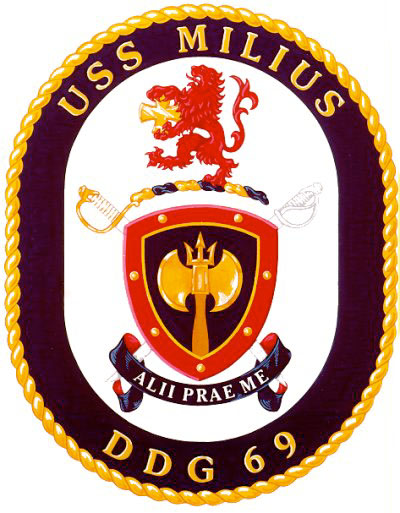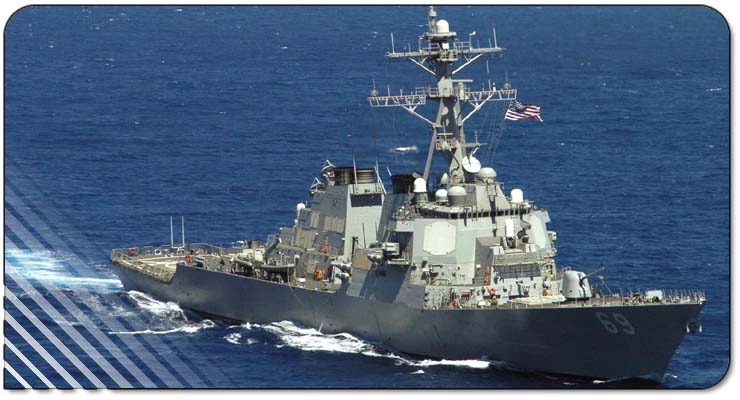Namesake:
Captain Paul L. Milius.
DDG 69 is named
in honor of the Navy pilot Captain Paul L. Milius. He was born 11
February, 1928, the youngest of four children, in Denver, Iowa, a
small, rural community in Bremer County in the northeastern part of the
state. He and the fifteen other members of the senior class graduated
from Readlyn High School in May of 1946. In April of 1946, just weeks
before graduation, Captain Milius received his selective service
notification and reported to his pre-induction physical examination at
the local examining board on the second floor of the Waverly Savings
Bank building in Waverly, Iowa. By 21 May of that year, the eighteen
year old son of C. H. and Christina Milius was in "boot camp" at the
Naval Training Center in San Diego, California, serving on active duty
in the United States Navy.
Captain Milius was discharged from active duty in March of 1948. His
enlisted naval experience in the aviation community had only enhanced
his lifelong intrigue with aircraft and his desire to fly. Knowing the
route to the cockpit begins with a college degree, he enrolled in Iowa
State Teacher's College, now the University of Northern Iowa, in Cedar
Falls. Captain Milius continued to serve in the Naval Reserve
throughout his time in college. In 1950, after attaining a two year
degree, he applied for and was accepted into the Naval Aviation Cadet
(NAVCAD) Program. In August 1950, he was back on active duty at the
Naval Air Station, Pensacola, Florida, attending the U.S. Naval School,
Pre-Flight course. He successfully completed this course on 16 December
1950 and was sent to advanced training at the Naval Air Station in
Corpus Christi, Texas. On 16 December 1951, Aviation Cadet Milius was
awarded the naval aviator's wings of gold. On 21 December, he accepted
the appointment and took the oath of office as an Ensign in the United
States Naval Reserve with the naval aviator's designator of 1325. On 30
December, he married his high school sweetheart (and class
valedictorian), Darlene Meyerhoff.
Captain Milius' early duty assignments as a naval aviator trained him
in the Airborne Early Warning community. He spent the first three years
of his career, from 1952 through 1955, attached to Airborne Early
Squadron TWO (VW-2) at Naval Air Station, Patuxent River, Maryland,
where he gained extensive experience flying the multi-engine Lockheed
Constellation (WV-1) aircraft. He was subsequently posted to the Naval
Air Station at Hutchinson, Kansas, where he served as a flight
instructor for the P-2V patrol aircraft until 1957. His daughter,
Annette, and son, David, were born during these years.
Following two years as a student at the General Line School in
Monterey, California, then Lieutenant Milius was assigned to Air
Anti-Submarine Squadron TWENTY-THREE in San Francisco flying the S-2
aircraft. He served briefly with Air Anti-Submarine Squadron
TWENTY-FIVE in Long Beach, California, before he was reassigned to
ship's company onboard the aircraft carrier USS KEARSARGE (CVS-33).
There he served in a variety of duties including Catapult and Arresting
Gear Officer from November 1960 through November 1962. While onboard
KEARSARGE, Captain Milius participated in the mission to retrieve
Walter Schirra's Mercury "Sigma 7" space capsule in 1962 and made two
Western Pacific deployments. In 1962, now Lieutenant Commander Milius
was assigned to Naval Air Station, Miramar, California, where he served
with Air Anti-Submarine Squadron FORTY-ONE (VS-41), filling a variety
of squadron billets specifically related to anti-submarine warfare and
S-2 aircraft tactics.
Following an assignment as Airborne ASW training officer at the Fleet
Air Electronic Training Unit Pacific, in Alameda, California, then
Commander Milius volunteered for duty in the newly established
Observation Squadron SIXTY SEVEN (VO-67). The new unit utilized
converted P-2V aircraft, now known as the OP-2E, heavily armored and
fitted with advanced land detection systems, for ground reconnaissance
missions. The squadron deployed to Khon Phnom Airport in Thailand in
1967 and immediately began flying surveillance missions in the vicinity
of the Ho Chi Min Trail. At 1157 local time on February 27, 1968,
Commander Milius and the crew of his OP-2E aircraft were on an
operational surveillance mission over Laos when the aircraft was hit in
the radar well by a large explosive projectile, presumed a 37MM
anti-aircraft fire. One crew member was mortally wounded by the initial
blast and fire broke out in the aircraft. As it became clear that the
aircraft could not be saved, Captain Milius took the controls from the
pilot, Lieutenant Bernie Walsh, and gave the crew the order to bail
out. Captain Milius continued to control the aircraft to enable his
crew to escape. Of eight surviving crew members of the initial blast,
all but Captain Milius were safely rescued on the ground by the 37th
Air Rescue Recovery Squadron Jolly Green Giants. Although Captain
Milius was seen exiting the burning aircraft, heavy enemy fire in that
area led to search efforts being discontinued before he could be
recovered. He was subsequently declared Missing In Action in Southeast
Asia in 1968. Captain Milius' status was changed to Presumed Killed In
Action ten years later. He was posthumously awarded the Navy Cross in
1978.
Warship MILIUS's motto, Alii Prae Me, or “Others Before
Myself,” was chosen to reflect the personal ethic held
throughout Captain Milius' military career and his selfless act under
fire.
|
Historical Notes:
Important Dates
in MILIUS History
August 23, 1993: Construction of DDG 69
begins.
August 8, 1994: DDG 69's keel is laid at the
Ingalls Shipbuilding site in Pascagoula, Mississippi.
August 1, 1995: The drydock is ballasted down
and the ship moved to her post-launch outfitting berth.
October 28, 1995: MILIUS is christened by Ann
Milius, CDR Paul Milius' daughter.
November 23, 1996: USS MILIUS is commissioned
with CDR Daine Eisold as her first Commanding Officer.
November 25, 1996: USS MILIUS leaves
Pascagoula, enroute to San Diego.
November 27-30, 1996: Port visit in Cozamel,
Mexico.
December 10-15, 1996: After transiting the
Panama Canal, port visit in Acapulco, Mexico.
December 16, 1996: USS MILIUS arrives at her
homeport of San Diego, California.
March, 1997: During Post Delivery Tests and
Trials in the Pacific, MILIUS visits the islands of Maui and Oahu.
May 6-10, 1997: MILIUS pulls into San
Francisco, California for her first stateside port visit.
September, 1997: MILIUS completes her Post
Shakedown Availability at South West Marine in San Diego and begins the
Tactical Training Cycle.
January 20, 1998: MILIUS completes the
Tactical Training Cycle by successfully finishing the Cruise Missile
Qualified Team trainer.
February 27, 1998: CDR Jim McManamon relieves
CDR Eisold as the ship's second Commanding Officer.
May 26, 1998: MILIUS leaves San Diego on her
maiden deployment.
June 1, 1998: Brief port visit to Pearl
Harbor, Hawaii.
June 10, 1998: Brief port visit to Guam.
June 18-23, 1998: Port visit to Singapore.
June 24-28 1998: Port visit to Phuket,
Thailand.
July 8, 1998: MILIUS enters the Arabian Gulf.
July 8-12, 1998: Port visit to Bahrain.
August 16-17, 1998: Port visit to Bahrain.
September 14-17, 1998: Port visit to Bahrain.
October 7-9, 1998: Port visit to Bahrain.
October 9, 1998: MILIUS departs the Arabian
Gulf.
October 22-27, 1998: Port visit to Darwin,
Australia.
October 31-November 5, 1998: Port visit to
Mackay, Australia.
November 14-17, 1998: Port visit to Pearl
Harbor, Hawaii.
November 23, 1998: MILIUS returns to San
Diego.
January 8, 1999: MILIUS enters the South West
Marine shipyard in San Diego for post-deployment yard availability.
March 16, 1999: MILIUS departs the shipyard.
May 7-9, 1999: Anchored off Santa Barabara,
California to take part in the Harbor Festival.
August 6-8, 1999: MILIUS participates in the
San Diego Harbor Pass and Review. Spends the weekend moored at Broadway
Pier downtown and is toured by hundreds.
October 29, 1999: CDR Tom Rowden relieves CDR
McManamon as the ship's third Commanding Officer.
November 12-15, 1999: Port visit to Mazatlan,
Mexico.
January 27-30, 2000: Port visit to Puerta
Vallarta, Mexico.
June 22, 2000: After another extensive
training cycle, MILIUS departs San Diego for her second deployment.
June 28-29, 2000: Brief port visit to Pearl
Harbor, Hawaii.
July 9-12, 2000: Port visit to Saipan,
Commonwealth of Northern Marianas Islands (CNMI).
July 18-22, 2000: Port visit to Hong Kong,
China.
July 27-31, 2000: Port visit to Singapore.
August 10, 2000: MILIUS enters the Arabian
Gulf.
August 11-14, 2000: Port visit to Bahrain.
August 29-31, 2000: Port visit to Abu Dhabi,
United Arab Emirates.
September 11-15, 2000: Port visit to Dubai,
United Arab Emirates.
November 22-27, 2000: Port Visit to
Freemantle, Australia
December 01-06, 2000: Port Visit to Sydney,
Australia
December 10, 2000: Port Visit to Pago Pago
December 16-17, 2000: Port Visit to Hawaii
December 22, 2000: Milius Returns to San Diego
February 14, 2000: Milius Post Deployment SRA
|
Ship's Crest:
 Symbolism: Symbolism:
The ship’s crest is
designed in remembrance of the military service of the ship’s
namesake, Captain Paul Lloyd Milius, and the courage and dedication
that promoted his selfless act of heroism.
Dark blue and gold are
colors traditionally used by the Navy and denote the sea and
excellence. The shield itself reflects the power of the Aegis shield.
The double-edged battle-ax symbolizes the power of the modern guided
missile destroyer. The battle-ax harnesses is a warning that peace
should be maintained; provoked and unleashed, the battle-ax is a
punishing offensive weapon capable of delivering crushing
blows. The trident reflects the prowess of MILIUS, capable of
projecting sea power on the land, in the air, and on and beneath the
sea. The crossed swords are the modern Navy sword of today
and the cutlass of the John Paul Jones ear symbolizing the enduring
tradition and heritage of the United States Navy. The border,
for unity, is red highlighting readiness for action and sacrifice, if
necessary. The seven bolts on the border represent the seven
lives saved by Captain Milius’ heroic action.
The lion suggests Captain
Milius’ extraordinary heroism as the aircraft commander in
Observation Squadron Sixty-Seven for which he received the Navy Cross,
represented by the cross plate, and underscored his selfless courage
and inspiring devotion to duty.
The translation of the Latin motto
is “OTHERS BEFORE MYSELF.”
|



 Symbolism:
Symbolism: 


















